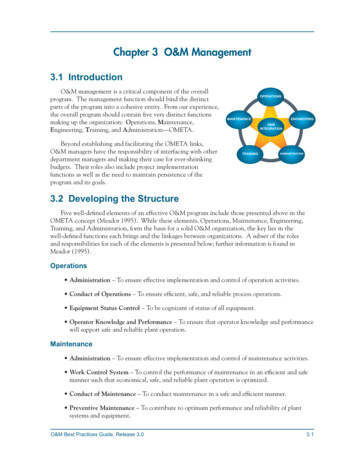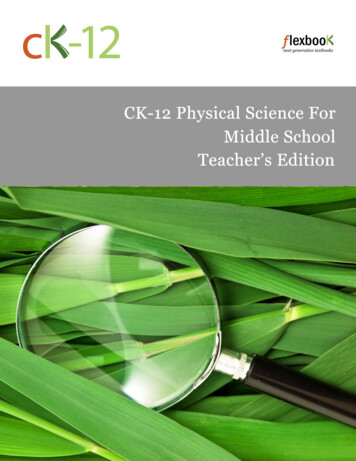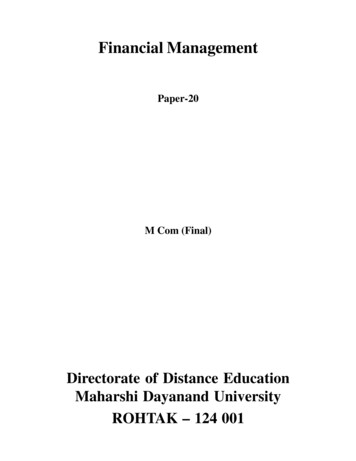
Transcription
Chapter 3 O&M Management3.1 IntroductionO&M management is a critical component of the overallprogram. The management function should bind the distinctparts of the program into a cohesive entity. From our experience,the overall program should contain five very distinct functionsmaking up the organization: Operations, Maintenance,Engineering, Training, and Administration—OMETA.Beyond establishing and facilitating the OMETA links,O&M managers have the responsibility of interfacing with otherdepartment managers and making their case for ever-shrinkingbudgets. Their roles also include project implementationfunctions as well as the need to maintain persistence of theprogram and its ONTRAININGADMINISTRATION3.2 Developing the StructureFive well-defined elements of an effective O&M program include those presented above in theOMETA concept (Meador 1995). While these elements, Operations, Maintenance, Engineering,Training, and Administration, form the basis for a solid O&M organization, the key lies in thewell-defined functions each brings and the linkages between organizations. A subset of the rolesand responsibilities for each of the elements is presented below; further information is found inMeador (1995).Operations Administration – To ensure effective implementation and control of operation activities. Conduct of Operations – To ensure efficient, safe, and reliable process operations. Equipment Status Control – To be cognizant of status of all equipment. Operator Knowledge and Performance – To ensure that operator knowledge and performancewill support safe and reliable plant operation.Maintenance Administration – To ensure effective implementation and control of maintenance activities. Work Control System – To control the performance of maintenance in an efficient and safemanner such that economical, safe, and reliable plant operation is optimized. Conduct of Maintenance – To conduct maintenance in a safe and efficient manner. Preventive Maintenance – To contribute to optimum performance and reliability of plantsystems and equipment.O&M Best Practices Guide, Release 3.03.1
O&M Management Maintenance Procedures and Documentation – To provide directions, when appropriate, forthe performance of work and to ensure that maintenance is performed safely and efficiently.Engineering Support Engineering Support Organization and Administration – To ensure effective implementationand control of technical support. Equipment Modifications – To ensure proper design, review, control, implementation, anddocumentation of equipment design changes in a timely manner. Equipment Performance Monitoring – To perform monitoring activities that optimizeequipment reliability and efficiency. Engineering Support Procedures and Documentation – To ensure that engineer supportprocedures and documents provide appropriate direction and that they support the efficiencyand safe operations of the equipment.Training Administration – To ensure effective implementation and control of training activities. General Employee Training – To ensure that plant personnel have a basic understanding oftheir responsibilities and safe work practices and have the knowledge and practical abilitiesnecessary to operate the plant safely and reliably. Training Facilities and Equipment – To ensure the training facilities, equipment, andmaterials effectively support training activities. Operator Training – To develop and improve the knowledge and skills necessary to performassigned job functions. Maintenance Training – To develop and improve the knowledge and skills necessary toperform assigned job functions.Administration Organization and Administration – To establish and ensure effective implementation ofpolicies and the planning and control of equipment activities. Management Objectives – To formulate and utilize formal management objectives to improveequipment performance. Management Assessment – To monitor and assess station activities to improve all aspects ofequipment performance. Personnel Planning and Qualification – To ensure that positions are filled with highlyqualified individuals. Industrial Safety – To achieve a high degree of personnel and public safety.3.2O&M Best Practices Guide, Release 3.0
O&M Management3.3 Obtain Management SupportFederal O&M managers need to obtain full support fromtheir management structure in order to carry out an effectivemaintenance program. A good way to start is by establishinga written maintenance plan and obtaining upper managementapproval. Such a management-supported program is veryimportant because it allows necessary activities to be scheduled with the same priority as other management actions.Approaching O&M by equating it with increased productivity,energy efficiency, safety, and customer satisfaction is one way togain management attention and support.Management reports should notassign blame for poor maintenanceand inefficient systems, but ratherto motivate efficiency improvementthrough improved maintenance.When designing management reports, the critical metrics used by each system should becompared to a base period. For example, compare monthly energy use against the same month forthe prior year, or against the same month in a particular base year (for example, 1985). If efficiencystandards for a particular system are available, compare your system’s performance against thatstandard as well. Management reports should not assign blame for poor maintenance and inefficientsystems, but rather to motivate efficiency improvement through improved maintenance.3.3.1 The O&M Mission StatementAnother useful approach in soliciting management buy-in and support is the development anO&M mission statement. The mission statement does not have to be elaborate or detailed. Themain objective is to align the program goals with those of site management and to seek approval,recognition, and continued support. Typical mission statements set out to answer criticalquestions – a sample is provided below: Who are we as an organization – specifically, the internal relationship? Whom do we serve – specifically, who are the customers? What do we do – specifically, what activities make up day-to-day actions? How do we do it – specifically, what are the beliefs and values by which we operate? Finally, how do we measure success – what metrics do we use, (e.g., energy/water efficiency,safety, dollar savings, etc.?)A critical element in mission statement development is involvement of upper management andfacility staff alike. Once involved with the development, there will be “ownership” which can leadto compliance (facility staff) and support (management).O&M Best Practices Guide, Release 3.03.3
O&M Management3.4 Measuring the Quality of Your O&M ProgramTraditional thinking in the O&M field focused on a single metric, reliability, for programevaluation. Every O&M manager wants a reliable facility; however, this metric alone is not enoughto evaluate or build a successful O&M program.Beyond reliability, O&M managers need to be responsible for controlling costs, evaluating andimplementing new technologies, tracking and reporting on health and safety issues, and expandingtheir program. To support these activities, the O&M manager must be aware of the variousindicators that can be used to measure the quality or effectiveness of the O&M program. Not onlyare these metrics useful in assessing effectiveness, but also useful in cost justification of equipmentpurchases, program modifications, and staff hiring.Below are a number of metrics that can be used to evaluate an O&M program. Not all of thesemetrics can be used in all situations; however, a program should use of as many metrics as possible tobetter define deficiencies and, most importantly, publicize successes. Capacity factor – Relates actual plant or equipment operation to the full-capacity operationof the plant or equipment. This is a measure of actual operation compared to full-utilizationoperation. Work orders generated/closed out – Tracking of work orders generated and completed (closedout) over time allows the manager to better understand workloads and better schedule staff. Backlog of corrective maintenance – An indicator of workload issues and effectiveness ofpreventive/predictive maintenance programs. Safety record – Commonly tracked either by number of loss-of-time incidents or total numberof reportable incidents. Useful in getting an overall safety picture. Energy use – A key indicator of equipment performance, level of efficiency achieved, andpossible degradation. Inventory control – An accurate accounting of spare parts can be an important element incontrolling costs. A monthly reconciliation of inventory “on the books” and “on the shelves”can provide a good measure of your cost control practices. Overtime worked – Weekly or monthly hours of overtime worked has workload, scheduling,and economic implications. Environmental record – Tracking of discharge levels (air and water) and non-compliancesituations. Absentee rate – A high or varying absentee rate can be a signal of low worker morale andshould be tracked. In addition, a high absentee rate can have a significant economic impact. Staff turnover – High turnover rates are also a sign of low worker morale. Significant costs areincurred in the hiring and training of new staff. Other costs include those associated with errorsmade by newly hired personnel that normally would not have been made by experienced staff.3.4O&M Best Practices Guide, Release 3.0
O&M ManagementWhile some metrics are easier to quantify than others, Table 3.1.1 below can serve as a guide fortracking and trending metrics against industry benchmarks (NASA 2000).Table 3.1.1. Industry O&M metrics and benchmarksMetricVariables and EquationBenchmarkEquipment Availability% Hours each unit is avaialbe to run at capacityTotal hours during the reporting time period 95%Schedule Compliance% Total hours worked on scheduled jobsTotal hours scheduled 90%Emergency Maintenance % Total hours worked on emergency jobsPercentageTotal hours workedMaintenance OvertimePercentage% Total maintenance overtime during periodTotal regular maintenance hour during periodPreventive Maintenance % Preventive maintenance actions completedCompletion PercentagePreventive maintenance actions scheduled 10% 5% 90%Preventive Maintenance % Budget/CostPreventive maintenance costTotal maintenance cost15% – 18%% Preventive maintenance costTotal maintenance cost10% – 12%Predictive MaintenanceBudget/Cost3.5 Selling O&M to ManagementTo successfully interest management in O&M activities, O&M managers need to be fluent inthe language spoken by management. Projects and proposals brought forth to management need tostand on their own merits and be competitive with other funding requests. While evaluation criteriamay differ, generally some level of economic criteria will be used. O&M managers need to have aworking knowledge of economic metrics such as: Simple payback – The ratio of total installedcost to first-year savings. Return on investment – The ratio of theincome or savings generated to the overallinvestment. Net present value – Represents the presentworth of future cash flows minus the initialcost of the project.Life-Cycle Cost TrainingTake advantage of LCC workshops offered byFEMP. Each year, FEMP conducts a 2-hour televisedworkshop on life-cycle cost methods and the use ofBLCC (Building Life-Cycle Cost) software programs.In some years, two-day classroom workshops areoffered at various U.S. locations.More information can be found at: .html Life-cycle cost – The present worth of allcosts associated with a project. FEMP offers life-cycle cost training along with its Building Life-Cycle Cost (BLCC) computerprogram at various locations during the year – see Appendix B for the FEMP training contacts.O&M Best Practices Guide, Release 3.03.5
O&M Management3.6 Program ImplementationDeveloping or enhancing an O&M program requires patience and persistence. Guidelines forinitiating a new O&M project will vary with agency and management situation; however, some stepsto consider are presented below: Start small – Choose a project that is manageable and can be completed in a short period of time,6 months to 1 year. Select troubled equipment – Choose a project that has visibility because of a problematic history. Minimize risk – Choose a project that will provide immediate and positive results. This projectneeds to be successful, and therefore, the risk of failure should be minimal. Keep accurate records – This project needs to stand on its own merits. Accurate, if notconservative, records are critical to compare before and after results. Tout the success – When you are successful, this needs to be shared with those involved and withmanagement. Consider developing a “wall of accomplishment” and locate it in a place wheremanagement will take notice. Build off this success – Generate the success, acknowledge those involved, publicize it, and thenrequest more money/time/resources for the next project.3.7 Program PersistenceA healthy O&M program is growing, not always in staff but in responsibility, capability,and accomplishment. O&M management must be vigilant in highlighting the capabilities andaccomplishments of their O&M staff.Finally, to be sustainable, an O&M program must be visible beyond the O&M management.Persistence in facilitating the OMETA linkages and relationships enables heightened visibility of theO&M program within other organizations.3.8 O&M ContractingApproximately 40% of all non-residential buildings contract maintenance service for heating,ventilation, and air conditioning (HVAC) equipment (PECI 1997). Discussions with Federalbuilding mangers and organizations indicate this value is significantly higher in the Federal sector, andthe trend is toward increased reliance on contracted services.In the O&M service industry, there is a wide variety of service contract types ranging from fullcoverage contracts to individual equipment contracts to simple inspection contracts. In a relativelynew type of O&M contract, called End-Use or End-Result contracting, the O&M contractor not onlytakes over all operation of the equipment, but also all operational risk. In this case, the contractoragrees to provide a certain level of comfort (space temperature, for instance) and then is compensatedbased on how well this is achieved.3.6O&M Best Practices Guide, Release 3.0
O&M ManagementFrom discussions with Federal sector O&M personnel, the predominant contract type is the fullcoverage contract (also referred to as the whole-building contract). Typical full-coverage contractterms vary between 1 and 5 years and usually include options for out-years.Upon review of several sample O&M contracts used in the Federal sector, it is clear that somedegree of standardization has taken place. For better or worse, some of these contracts contain a highdegree of “boiler plate.” While this can make the contract very easy to implement, and somewhatuniform across government agencies, the lack of site specificity can make the contract ambiguous andopen to contractor interpretation often to the government’s disadvantage.When considering the use of an O&M contract, it is important that a plan be developed toselect, contract with, and manage this contract. In its guide, titled Operation and Maintenance ServiceContracts (PECI 1997), Portland Energy Conservation, Inc. did a particularly good job in presentingsteps and actions to think about when considering an O&M contract. A summary of these steps areprovided below.Steps to Think About When Considering an O&M Contract Develop objectives for an O&M service contract, such as:– Provide maximum comfort for building occupants.– Improve operating efficiency of mechanical plant (boilers, chillers, cooling towers, etc.).– Apply preventive maintenance procedures to reduce chances of premature equipment failures.– Provide for periodic inspection of building systems to avoid emergency breakdown situations. Develop and apply a screening process. The screening process involves developing a series ofquestions specific to your site and expectations. The same set of questions should be asked toperspective contractors and their responses should be rated. Select two to four potential contractors and obtain initial proposals based on each contractor’sbuilding assessments. During the contractors’ assessment process, communicate the objectivesand expectations for the O&M service contract and allow each contractor to study the buildingdocumentation. Develop the major contract requirements using the contractors’ initial proposals. Make sure toinclude the requirements for documentation and reporting. Contract requirements may also bedeveloped by competent in-house staff or a third party. Obtain final bids from the potential contractors based on the owner-developed requirements. Select the contractor and develop the final contract language and service plan. Manage and oversee the contracts and documentation.– Periodically review the entire contract. Build in a feedback process.The ability of Federal agencies to adopt the PECI-recommended steps will vary. Still, these stepsdo provide a number of good ideas that should be considered for incorporation into Federal maintenance contracts procurements.O&M Best Practices Guide, Release 3.03.7
O&M Management3.8.1 O&M Contract TypesThere are four predominant types of O&M contracts. These are: full coverage contracts, fulllabor contracts, preventive-maintenance contracts, and inspection contracts. Each type of contractis discussed below (PECI 1997).Full-Coverage Service Contract. A full-coverage service contract provides 100% coverageof labor, parts, and materials as well as emergency service. Owners may purchase this type ofcontract for all of their building equipment or for only the most critical equipment, depending ontheir needs. This type of contract should always include comprehensive preventive maintenancefor the covered equipment and systems. If it is not already included in the contract, for anadditional fee the owner can purchase repair and replacement coverage (sometimes called a“breakdown” insurance policy) for the covered equipment. This makes the contractor completelyresponsible for the equipment. When repair and replacement coverage is part of the agreement,it is to the contractor’s advantage to perform rigorous preventive maintenance on schedule, sincehe or she must replace the equipment if it fails prematurely.Full-coverage contracts are usually the most comprehensive and the most expensive type ofagreement in the short term. In the long term, however, such a contract may prove to be themost cost-effective, depending on the owner’s overall O&M objectives. Major advantages of fullcoverage contracts are ease of budgeting and the fact that most if not all of the risk is carried bythe contractor. However, if the contractor is not reputable or underestimates the requirements ofthe equipment to be insured, the contractor may do only enough preventive maintenance to keepthe equipment barely running until the end of the contract period. Also, if a company underbidsthe work in order to win the contract, the company may attempt to break the contract early ifit foresees a high probability of one or more catastrophic failures occurring before the end of thecontract.Full-Labor Service Contract. A full-labor service contract covers 100% of the labor to repair,replace, and maintain most mechanical equipment. The owner is required to purchase allequipment and parts. Although preventive maintenance and operation may be part of theagreement, actual installation of major plant equipment such as a centrifugal chillers, boilers, andlarge air compressors is typically excluded
O&M Best Practices Guide, Release 3.0 3.1 Chapter 3 O&M Management 3.1 Introduction O&M management is a critical component of the overall program. The management function should bind the distinct parts of the program into a cohesive entity. From our experience, the o











